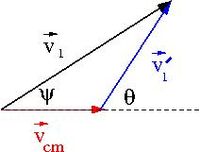Difference between revisions of "Forest UCM MiNF"
| Line 124: | Line 124: | ||
:<math>\vec{F}_{\mbox{tide}} = G \frac{M_m M_o}{d^3}\vec d - G \frac{M_m }{d_0^3}\vec d_0 </math> | :<math>\vec{F}_{\mbox{tide}} = G \frac{M_m M_o}{d^3}\vec d - G \frac{M_m }{d_0^3}\vec d_0 </math> | ||
::<math> = G M_m M_o \left ( \frac{\vec d}{d^3} - \frac{\vec d_0}{d_0^3}\right ) </math> | ::<math> = G M_m M_o \left ( \frac{\vec d}{d^3} - \frac{\vec d_0}{d_0^3}\right ) </math> | ||
| + | |||
| + | Let's consider two cases, one where M_o is directly between the moon and the earth and the other when the mass is directly on the opposite side of the earth from the moon. | ||
| + | |||
| + | ;Case 1: The mass is directly between the moon and the earth | ||
| + | |||
| + | :In this case <math>\vec d \para \vec d_0 </math> | ||
[[Forest_Ugrad_ClassicalMechanics]] | [[Forest_Ugrad_ClassicalMechanics]] | ||
Revision as of 13:28, 5 November 2014
Mechanics in Noninertial Reference Frames
Linearly accelerating reference frames
Let represent an inertial reference frame and \mathcal S represent an noninertial reference frame with acceleration relative to .
Ball thrown straight up
Consider the motion of a ball thrown straight up as viewed from .
Using a Galilean transformation (not a relativistic Lorentz transformation)
At some instant in time the velocities add like
where
- = velocity of moving frame with respect to at some instant in time
taking derivative with respect to time
where
- inertial force
- in your noninertial frame, the ball appears to have a force causing it to accelerate in the direction.
The inertial force may also be referred to as a fictional force
an example is the "fictional" centrifugal force for rotational acceleration.
The observer in a noninertial reference frame will feel these frictional forces as if they are real but they are really a consequence of your accelerating reference frame
example
- A force pushes you back into your seat when your Jet airplane takes off
- you slam on the brakes and hit your head on the car's dashboard
Pedulum in an accelerating car
Consider a pendulum mounted inside a car that is accelerating to the right with a constant acceleration .
What is the pendulums equilibrium angle
In frame
In frame
If the pendulum is at rest and not oscillating then
is the vector sum of and which are orthogonal to each other in this problem thus
The pendulum oscillation frequency as seen in the accelerating car is
- Using lagrangian mechanics in the inertial frame
The tides
The gravitational force between the moon and the earth accelerates the earth and the ocean towards the moon.
The moon of mass pulls on the earth of mass such that
where is the earth-moon distance of separation.
- Earth's acceleration towards the moon that makes the earth a non-inertial reference frame
The moon of mass pulls on a test mass of water on the surface of the earth's ocean such that
As seen in the Earth non-inertial reference frame
where
- a net non-graviational force hold the mass M_o in top of the ocean (Bouyant force)
Let's consider two cases, one where M_o is directly between the moon and the earth and the other when the mass is directly on the opposite side of the earth from the moon.
- Case 1
- The mass is directly between the moon and the earth
- In this case
